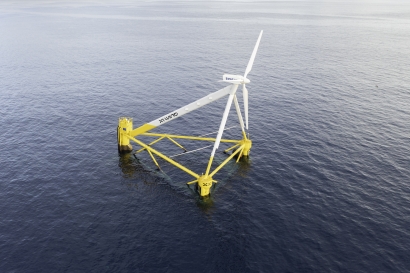
X1 Wind Operations Manager Jorge Casanovas said operations will soon commence collecting valuable data to validate performance in open ocean conditions for the first time.
"As installation work comes to a close another exciting chapter begins for X1 Wind as we prepare for operations to deliver first power to the PLOCAN smartgrid," he said. "This is the result of a massive team effort, and we would like to extend our appreciation to all project partners and local suppliers who have supported so diligently throughout the build and installation process.
"We are especially thankful to those partners and suppliers that have played an instrumental role in the final installation phase, developing a ground-breaking mooring, connection and installation solution for our X30 prototype. Now successfully installed, we will begin monitoring the platform in real-time with multiple sensors integrated within our in-house SCADA system."
The X30 platform has been developed with several key design features to streamline the installation process, including a light-weight and stable floater which can be easily wet towed by local vessels. The PivotBuoy Project focuses on demonstrating an innovative mooring system configuration that combines the advantages of a SPM (single point mooring) with a small TLP (Tension-Leg Platform) mooring system, allowing the ability to reach deeper waters and minimizing the footprint and impact on the seabed.
Fitted with a Vestas V29 turbine, the 1:3 scale prototype has been stationed at a 50m water depth in a downwind configuration, creating a passive 'weathervaning' effect that eliminates the need of an active yaw system. The scalability of X1 Wind's technology will enable the firm to provide platforms for the 15MW scale turbines and beyond and to deploy them at very deep sites.
X1 Wind CEO and Co-Founder Alex Raventos said commercial scale plans are now gathering pace and will leverage the learnings from the PivotBuoy prototype.
"This is a key milestone for our company and for the floating wind sector in general being able to install a floating wind platform using a TLP mooring system and requiring only small vessels. This reduces not only the costs but also the impact on the seabed. Data obtained from the X30 will contribute to de-risk the technology, improve the design, and obtain the certification of our commercial-scale platforms in preparation for upcoming tenders in Spain and other countries worldwide," he said.
The Barcelona-headquartered company was recently selected by the European Commission to deliver the NextFloat project - an ambitious program accelerating industrial-scale floating wind aiming to install its first commercial-scale platform in the South of France.
After completing the installation, the PivotBuoy project will be tested in fully operational conditions until March 2023, feeding the electricity produced to PLOCAN's smartgrid, after it has been commissioned.
The PivotBuoy Project is backed by a €4 million grant from the European Commission H2020 Program. Led by X1 Wind the consortium includes leading companies EDP NEW, DNV, INTECSEA, ESM and DEGIMA and world-class research centres WavEC, DTU and PLOCAN.
Executive Board Member of EDP NEW, João Maciel said, "The World is facing unprecedented challenges. Decarbonization through Renewable Generation will be key. The oceans and the sustainable exploration of offshore renewables are paramount for a greener, decarbonized world. Floating offshore wind has been slowly but steadily showing it is a growth avenue for renewables and promising technologies such as X1 Wind's are the cornerstone for the grand challenge – to accelerate competitiveness of the sector. And we love to see these new projects / technologies coming to life."
DNV representative, Claudio Bittencourt mentioned the importance of the completion of installation of PivotBuoy. "The experience acquired so far during design, manufacturing and installation is vital for the consolidation and improvement of the technology. Soon the PivotBuoy project will start providing operational data, following years of work on this innovative technology. This will provide vital support for the next development of the full-scale technology."

